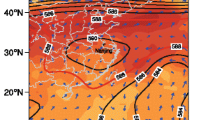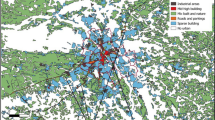Abstract
The urban heat island is a representative urban climate characteristic, which can affect heat-stress conditions and extreme precipitation that are closely connected with human life. Better understanding of urban-climate interactions, therefore, is crucial to ultimately support better planning and adaptation in various application fields. This study assesses urban-climate interactions during summer for eastern North America using regional climate model simulations at 0.22° resolution. Two regional climate model experiments, with and without realistic representation of urban regions, are performed for the 1981–2010 period. Comparison of the two experiments shows higher mean temperatures and reduced mean precipitation in the simulation with realistic urban representation, which can be attributed primarily to reduced albedo and soil moisture for the urban regions in this simulation. Furthermore, the mean temperature and precipitation in the simulation with improved urban representation is also closer to that observed. Analysis of short-duration precipitation extremes for climatologically different sub-regions, however, suggests that, for higher temperatures, the magnitudes of precipitation extremes are generally higher in the simulation with realistic urban representation, particularly for coastal urban regions, and are collocated with higher values of convective available potential energy and cloud fraction. Enhanced sea and lake breezes associated with lower sea level pressure found around these regions, contribute additional water vapor and further enhance dynamic convective development, leading to higher precipitation intensities. Analysis of temperature extremes clearly demonstrates that urban regions experience aggravated heat-stress conditions due to relatively higher temperatures despite reduced relative humidity. Double the number of extreme heat spells lasting six or more days are noted for the coastal urban regions in the study domain. This study, in addition to demonstrating the differences in urban-climate interactions for climatologically different regions, also demonstrates the need for better representation of urban regions in climate models to generate realistic climate information.










Similar content being viewed by others
References
Balk DL, Deichmann U, Yetman G, Pozzi F, Hay SI, Nelson A (2006) Determining global population distribution: method, application and data. Adv Parasitol 62:119–156
Bélair S, Mailhot J, Girard C, Vaillancourt P (2005) Boundary layer and shallow cumulus coulds in a medium-range forecast of a large-scale weather system. Mon Weather Rev 133:1938–1960
Bélair S, Leroyer S, Seino N, Spacek L, Souvanlasy V, Paouin-Ricard D (2018) Role and impact of the urban environment in a numerical forecast of an intense summertime precipitation event over Tokyo. J Meteorol Soc Japan 96A:77–94
Benoit R, Cote J, Mailhot J (1989) Inclusion of a Tke boundary-layer parameterization in the Canadian regional finite-element model. Mon Weather Rev 117(8):1726–1750
Cha DH et al (2016) Future changes in summer precipitation in regional climate simulations over the Korean Peninsula forced by multi-RCP scenarios of HadGEM2-AO. Asia–pac J Atmos Sci 52:139–149
Cote J, Gravel S, Methot A, Patoine A, Roch M, Staniforth A (1998) The operational CMC-MRB global environmental multiscale (GEM) model. Part I: design considerations and formulation. Mon Weather Rev 126(6):1373–1395
Daniel M, Lemonsu A, Deque M, Somot S, Alias A, Masson V (2019) Benefits of explicit urban parameterization in regional climate modeling to study climate and city interactions. Clim Dyn 52:2745–2764
Dee DP et al (2011) The ERA-Interim reanalysis: configuration and performance of the data assimilation system. Q J R Meteorol Soc 137(656):553–597
Delage Y (1997) Parameterising sub-grid scale vertical transport in atmospheric models under statistically stable conditions. Bound-Layer Meteorol 82:23–48
Hamdi R, Degrauwe D, Termonia P (2012) Coupling the town energy balance (TEB) scheme to an operational limited-area NWP model: evaluation for a highly urbanized area in Belgium. Weather Forecast 27:323–344
Hersbach H et al (2020) The ERA5 global reanalysis. Q J R Meteorol Soc. https://doi.org/10.1002/qj.3803
Huszar P, Halenka T, Belda M, Zak M, Sindelarova K, Miksovsky J (2014) Regional climate model assessment of the urban land-surface forcing over central Europe. Atmos Chem Phy 14:12393–12413
IPCC (2007) Climate Change 2007. In the physical science basis. In: Solomon S, Qin D, Manning M, Chen Z, Marquis M, Averyt KB, Tignor M, Miller HL (eds) Contribution of working group I to the fourth assessment report of the intergovernmental panel on climate Change. Cambridge University Press, Cambridge, New York, p 996
Jeong DI, Sushama L (2016) Projected changes to high temperature events for Canada based on a regional climate model ensemble. Clim Dyn 46:3163–3180
Kain JS, Fritsch JM (1992) The role of the convective “trigger function” in numerical forecasts of mesoscale convective system. Meteorol Atmos Phy 49:93–106
Karlicky J et al (2018) Multi-model comparison of urban heat island modelling approaches. Atmos Chem Phy 18:10655–10674
Karlicky J et al (2020) The urban meteorology island: a multi-model ensemble analysis. Atmos Chem Phys Discuss. https://doi.org/10.5194/acp-2020-433
Lenderink G, van Meijgaard E (2010) Linking increases in hourly precipitation extremes to atmospheric temperature and moisture changes. Environ Res Lett. https://doi.org/10.1088/1748-9326/5/2/025208
Leroyer S, Bélair S, Mailhot J, Strachan IB (2011) Microscale numerical prediction over Montreal with the Canadian external urban modeling system. J Appl Meteorol Climatol 50:2410–2428
Li J, Barker HW (2005) A radiation algorithm with correlated-k distribution. Part I: local thermal equilibrium. J Atmos Sci 62(2):286–309
Li XX, Koh TY, Panda J, Norford LK (2016) Impact of urbanization patterns on the local climate of a tropical city, Singapore: an ensemble study. J Geophys Res Atmos 121:4386–4403
Manola et al (2020) Analysis of urban rainfall from hourly to seasonal scales using high-resolution radar observations in the Netherlands. Int J Climatol 40:822–840
Martynov A, Laprise R, Sushama L, Winger K, Separovic L, Dugas B (2013) Reanalysis-driven climate simulation over CORDEX North America domain using the Canadian regional climate model, version 5: model performance evaluation. Clim Dyn. https://doi.org/10.1007/s00382-013-1778-9
Masson V (2000) A physically-based scheme for the urban energy budget in atmospheric models. Bound-Layer Meteorol 94:357–3970
Masson V, Grimmond CSB, Oke TR (2002) Evaluation of the town energy balance (TEB) scheme with direct measurements from dry district in two cities. J Appl Meteorol 41:1011–1026
McCarthy MP, Best MJ, Betts RA (2010) Climate change in cities due to global warming and urban effects. Geophy Res Lett. https://doi.org/10.1029/2010GL042845
Miao S, Dou J, Chen F, Li J, Li A (2012) Analysis of observations on the urban surface energy balance in Beijing. Sci China Earth Sci 55(11):1881–1890
Molders N, Olson MA (2004) Impact of urban effects on precipitation in high latitutes. J Hydrometeorol 5:409–429
Nazarnia N, Schwick C, Jaeger J (2016) Accelerated urban sprawl in Montreal, Quebec City: and Zurich: investigating the differences using time series 1951–2011. Ecol Indic 60:1229–1251
Oh SG, Sushama L (2020) Short-duration precipitation extremes characteristics over Canada in a warmer climate. Clim Dyn 54(3):2493–2509
Oke TR (1982) The energetic basis of the urban heat island. Q J R Meteorol Soc 108:1–24
Oke TR (1988) The urban energy balance. Prog Phys Geogr 12:471–508
Oleson KW (2012) Contrasts between urban and rural climate in CCSM4 CMIP5 climate change scenarios. J Clim 25:1390–1412
Oleson KW, Bonan GB, Feddema J, Jackson T (2011) An examination of urban heat island characteristics in a global climate model. Int J Climatol 31:1848–1865
Oleson KW et al (2015) Interactions between urbanization, heat stress, and climate change. Clim Change 129:525–541
Roberge F, Sushama L (2018) Urban heat island in current and future climates for the island of Montreal. Sustain Cities Soc 40:501–512
Scaff L, Prein AF, Li Y, Liu C, Rasmussen R, Ikeda K (2019) Simulating the convective precipitation diurnal cycle in North America’s current and future climate. Clim Dyn. https://doi.org/10.1007/s00382-019-04757-9
Shepherd JM, Burian SJ (2003) Detection of urban-induced rainfall anomalies in a major coastal city. Earth Interact 7:1–17
Smoyer KE (1998) A comparative analysis of heat waves and associated mortality in St. Louis, Missouri—1980 and 1995. Int J Biometeorol 42:44–50
Steadman RG (1984) A universal scale of apparent temperature. J Clim Appl Meteorol 23:1674–1687
Steinweg C, Gutowski WJ (2015) Projected changes in greater St. Louis summer heat stress in NARCCAP simulation. Weather Clim Soc 7:159–168
Sundqvist H, Berge E, Kristjánsson JE (1989) Condensation and cloud parameterization studies with a mesoscale numerical weather prediction model. Mon Weather Rev 117:1641–1657
Teufel B et al (2017) Investigation of the 2013 Alberta flood from weather and climate perspectives. Clim Dyn 48:2881–2899
Thornton PE et al (2017) Daymet: daily surface water data on a 1 km grid for North America, version 3, ORNL DAAC, Oak Ridge, Tennessee, USA. https://doi.org/10.3334/ORNLDAAC/1328
Verseghy DL (2009) CLASS-The Canadian land surface scheme (version 3.4)-technical documentation (version 1.1). Internal report, Climate Research Division, Science and Technology Branch, Environment Canada, p 183
Wang D, Jiang P, Wang G, Wang D (2015) Urban extent enhances extreme precipitation over the Pearl River Delta, China. Atmos Sci Lett 16:310–317
Yeh KS, Cote J, Gravel S, Methot A, Patoine A, Roch M, Staniforth A (2002) The CMC-MRB global environmental multiscale (GEM) model. Part III: nonhydrostatic formulation. Mon Weather Rev 130(2):339–356
Zadra A, McTaggart-Cowan R, Roch M (2012) Recent changes to the orographic blocking. Seminar presentation, PRN, Dorval, Canada, 30 March 2012. http://collaboration.cmc.ec.gc.ca/science/rpn/SEM/dossiers/2012/seminaires/2012-03-30/Seminar_2012-03-30_Ayrton-Zadra.pdf. Accessed 27 Aug 2018
Zhang H, Wu C, Chen W, Huang G (2019) Effect of urban expansion on summer rainfall in the Pearl River Delta, South China. J Hydrol 568:747–757
Acknowledgements
The first author would like to thank Vincent Poitras and Bernardo Teufel with the processing of the urban geophysical fields. The GEM simulations considered in this study were performed on the supercomputer managed by Compute Canada and Calcul Québec. Model output data and analysis data for this study are available for request to the corresponding author (seokgeunoh@snu.ac.kr).
Author information
Authors and Affiliations
Corresponding author
Additional information
Publisher's Note
Springer Nature remains neutral with regard to jurisdictional claims in published maps and institutional affiliations.
Supplementary Information
Below is the link to the electronic supplementary material.
Rights and permissions
About this article
Cite this article
Oh, SG., Sushama, L. Urban-climate interactions during summer over eastern North America. Clim Dyn 57, 3015–3028 (2021). https://doi.org/10.1007/s00382-021-05852-3
Received:
Accepted:
Published:
Issue Date:
DOI: https://doi.org/10.1007/s00382-021-05852-3




